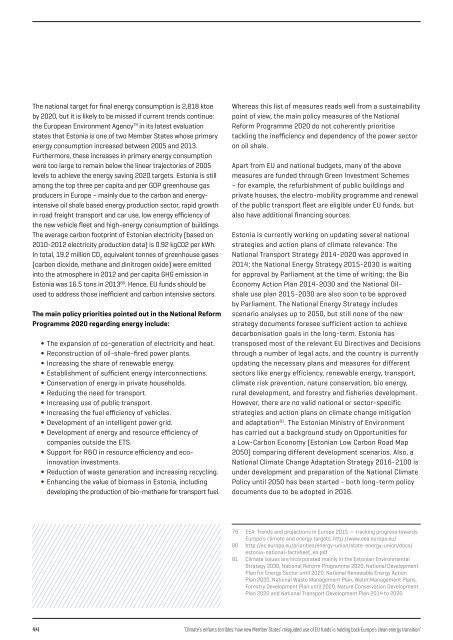ENFANTS TERRIBLES
enfants-terribles
enfants-terribles
You also want an ePaper? Increase the reach of your titles
YUMPU automatically turns print PDFs into web optimized ePapers that Google loves.
The national target for final energy consumption is 2,818 ktoe<br />
by 2020, but it is likely to be missed if current trends continue:<br />
the European Environment Agency 79 in its latest evaluation<br />
states that Estonia is one of two Member States whose primary<br />
energy consumption increased between 2005 and 2013.<br />
Furthermore, these increases in primary energy consumption<br />
were too large to remain below the linear trajectories of 2005<br />
levels to achieve the energy saving 2020 targets. Estonia is still<br />
among the top three per capita and per GDP greenhouse gas<br />
producers in Europe – mainly due to the carbon and energyintensive<br />
oil shale based energy production sector, rapid growth<br />
in road freight transport and car use, low energy efficiency of<br />
the new vehicle fleet and high-energy consumption of buildings.<br />
The average carbon footprint of Estonian electricity (based on<br />
2010-2012 electricity production data) is 0.92 kgC02 per kWh.<br />
In total, 19.2 million CO 2<br />
equivalent tonnes of greenhouse gases<br />
(carbon dioxide, methane and dinitrogen oxide) were emitted<br />
into the atmosphere in 2012 and per capita GHG emission in<br />
Estonia was 16.5 tons in 2013 80 . Hence, EU funds should be<br />
used to address those inefficient and carbon intensive sectors.<br />
The main policy priorities pointed out in the National Reform<br />
Programme 2020 regarding energy include:<br />
• The expansion of co-generation of electricity and heat.<br />
• Reconstruction of oil-shale-fired power plants.<br />
• Increasing the share of renewable energy.<br />
• Establishment of sufficient energy interconnections.<br />
• Conservation of energy in private households.<br />
• Reducing the need for transport.<br />
• Increasing use of public transport.<br />
• Increasing the fuel efficiency of vehicles.<br />
• Development of an intelligent power grid.<br />
• Development of energy and resource efficiency of<br />
companies outside the ETS.<br />
• Support for R&D in resource efficiency and ecoinnovation<br />
investments.<br />
• Reduction of waste generation and increasing recycling.<br />
• Enhancing the value of biomass in Estonia, including<br />
developing the production of bio-methane for transport fuel.<br />
Whereas this list of measures reads well from a sustainability<br />
point of view, the main policy measures of the National<br />
Reform Programme 2020 do not coherently prioritise<br />
tackling the inefficiency and dependency of the power sector<br />
on oil shale.<br />
Apart from EU and national budgets, many of the above<br />
measures are funded through Green Investment Schemes<br />
– for example, the refurbishment of public buildings and<br />
private houses, the electro-mobility programme and renewal<br />
of the public transport fleet are eligible under EU funds, but<br />
also have additional financing sources.<br />
Estonia is currently working on updating several national<br />
strategies and action plans of climate relevance: The<br />
National Transport Strategy 2014-2020 was approved in<br />
2014; the National Energy Strategy 2015-2030 is waiting<br />
for approval by Parliament at the time of writing; the Bio<br />
Economy Action Plan 2014-2030 and the National Oilshale<br />
use plan 2015-2030 are also soon to be approved<br />
by Parliament. The National Energy Strategy includes<br />
scenario analyses up to 2050, but still none of the new<br />
strategy documents foresee sufficient action to achieve<br />
decarbonisation goals in the long-term. Estonia has<br />
transposed most of the relevant EU Directives and Decisions<br />
through a number of legal acts, and the country is currently<br />
updating the necessary plans and measures for different<br />
sectors like energy efficiency, renewable energy, transport,<br />
climate risk prevention, nature conservation, bio energy,<br />
rural development, and forestry and fisheries development.<br />
However, there are no valid national or sector-specific<br />
strategies and action plans on climate change mitigation<br />
and adaptation 81 . The Estonian Ministry of Environment<br />
has carried out a background study on Opportunities for<br />
a Low-Carbon Economy (Estonian Low Carbon Road Map<br />
2050) comparing different development scenarios. Also, a<br />
National Climate Change Adaptation Strategy 2016-2100 is<br />
under development and preparation of the National Climate<br />
Policy until 2050 has been started - both long-term policy<br />
documents due to be adopted in 2016.<br />
79<br />
80<br />
81<br />
EEA: Trends and projections in Europe 2015 — tracking progress towards<br />
Europe’s climate and energy targets, http://www.eea.europa.eu/<br />
http://ec.europa.eu/priorities/energy-union/state-energy-union/docs/<br />
estonia-national-factsheet_en.pdf<br />
Climate issues are incorporated mainly in the Estonian Environmental<br />
Strategy 2030, National Reform Programme 2020, National Development<br />
Plan for Energy Sector until 2020, National Renewable Energy Action<br />
Plan 2020, National Waste Management Plan, Water Management Plans,<br />
Forestry Development Plan until 2020, Nature Conservation Development<br />
Plan 2020 and National Transport Development Plan 2014 to 2020<br />
44<br />
‘Climate’s enfants terribles: how new Member States’ misguided use of EU funds is holding back Europe’s clean energy transition’


